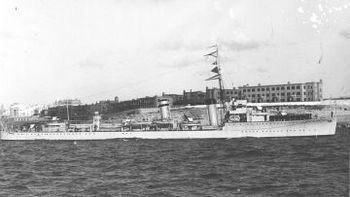Name HMS Montrose Commissioned 14 December 1919 Launched 29 May 1919 Weight 1,555 tons Draft 4.3 m | Laid down 27 March 1918 Construction started 27 March 1918 Length 98 m Displacement 1.388 million kg | |
 | ||
Honours andawards Atlantic 1939-40Dunkirk 1940Arctic 1942-43North Sea 1942-44English Channel 1943-44Normandy 1944 Fate Sold to be broken up for scrap on 25 July 1945 Class and type Admiralty-type destroyer leader | ||
The first HMS Montrose was one of eight Admiralty-type destroyer leaders, sometimes known as the Scott class. They were named after figures from Scottish history; Montrose was named for the Graham Dukes of Montrose. She was built during the First World War, but was completed too late for service then. However, she had a long career in the inter-war years and saw extensive service during the Second World War.
Contents
Construction
Montrose was ordered under the Wartime Emergency Construction Programme in April 1917, from Hawthorn Leslie of Hebburn. She was laid down at Hebburn-on-Tyne on 17 September 1917, launched in June 1918 and completed on 14 September that year, too late for her to be actively involved in the First World War.
Service history
In 1921 Montrose was sent to the Mediterranean Fleet where she would be stationed for an astonishing ten years, being involved in a number of operations during her attachment to the Fleet. One of her first duties was assisting in the evacuation of the remnants of the White Army at Novorossiysk, a harbour near the Black Sea, in March 1920. Many other Royal Navy warships assisted in the evacuation, along with British forces on land.
She finally returned home in 1929, serving initially in the Nore Reserve Fleet, then with the more prestigious Home Fleet from 1930 to 1932, before being placed into Reserve until she was given her eventual refit at Devonport shortly before World War II began. In 1939 she was made leader of the 17th Destroyer Flotilla, stationed with the Western Approaches Command, and for the first few months back in active service was tasked with anti-submarine patrols in the East Atlantic.
On 27 May 1940 she again assisted in an evacuation, this time the legendary Evacuation of Dunkirk, successfully evacuating 925 troops. On 29 May she collided with Sun V (United Kingdom) in the English Channel off Cap Gris Nez, Pas-de-Calais, France and was severely damaged. She was beached to prevent her sinking. Later refloated and towed back to Dover, Kent by Lady Brassey and Simla (both United Kingdom) and repaired.
Two months later, after she had been transferred to the 18th Destroyer Flotilla, Nore Command, she was damaged once again by enemy aircraft, while protecting minesweepers on the east coast. While in this action she shot down at least one enemy aircraft, though she had been disabled due to damage that she had sustained by a number of near-misses. She was subsequently towed back to Chatham for repairs that were to last over a year. On return from these repairs she was reallocated to the 16th Destroyer Flotilla where she would see out the remainder of her career.
From September 1942 and well into January 1943, she was employed in escorting convoys to North Russia, before she resumed coastal patrols off Britain, as well as covering the east coast convoys. Her last action of the war came about supporting the Normandy Landings. She won the lineage its last battle honour during these operations. Montrose was also damaged while supporting the invasion and had to be towed to Immingham for repairs. These were never completed, and she was thus placed in reserve and subsequently decommissioned in 1946. She was sold to Hughes Bolckow Ltd on 31 January 1946 and scrapped at Blyth in Northumberland.
